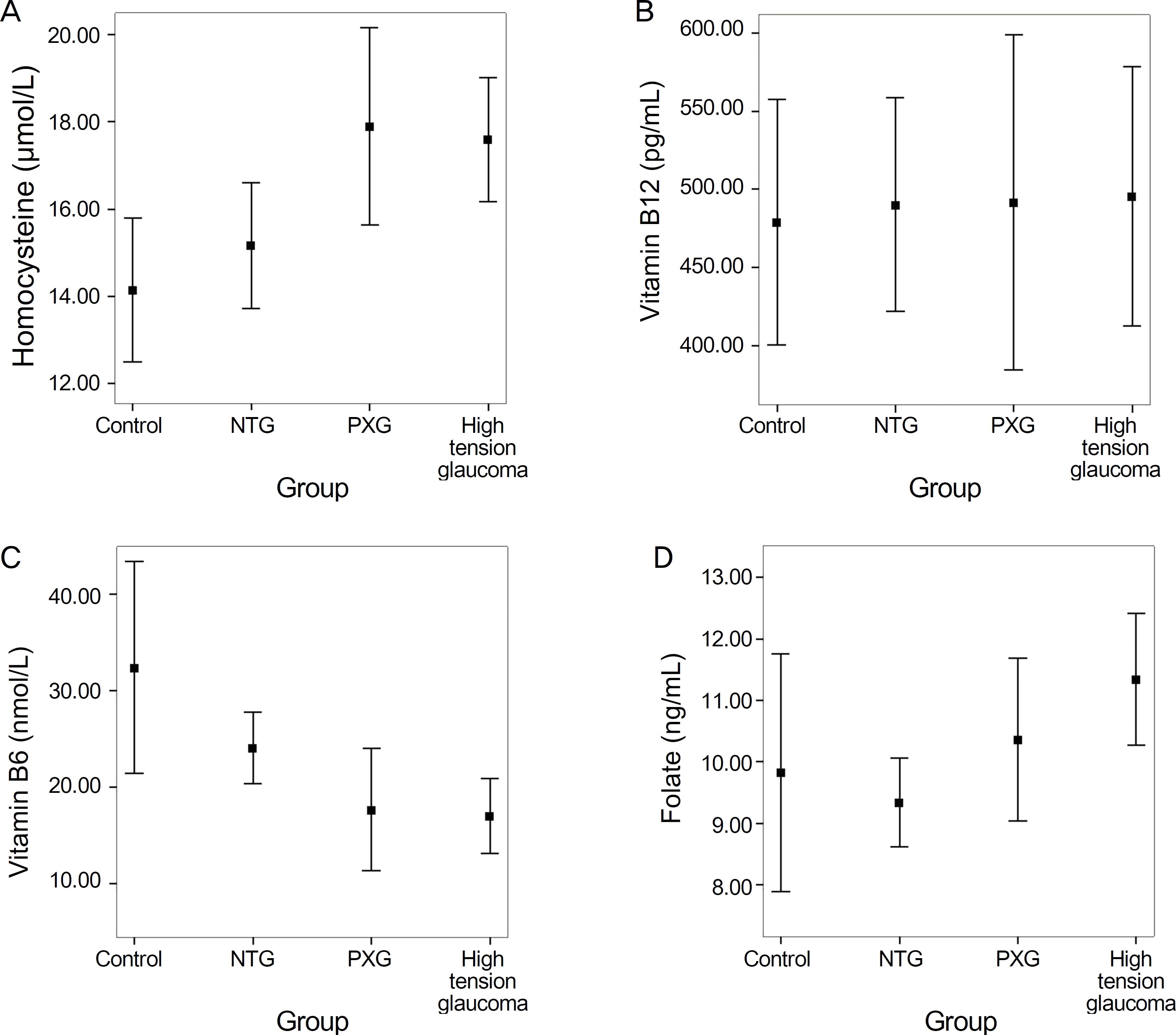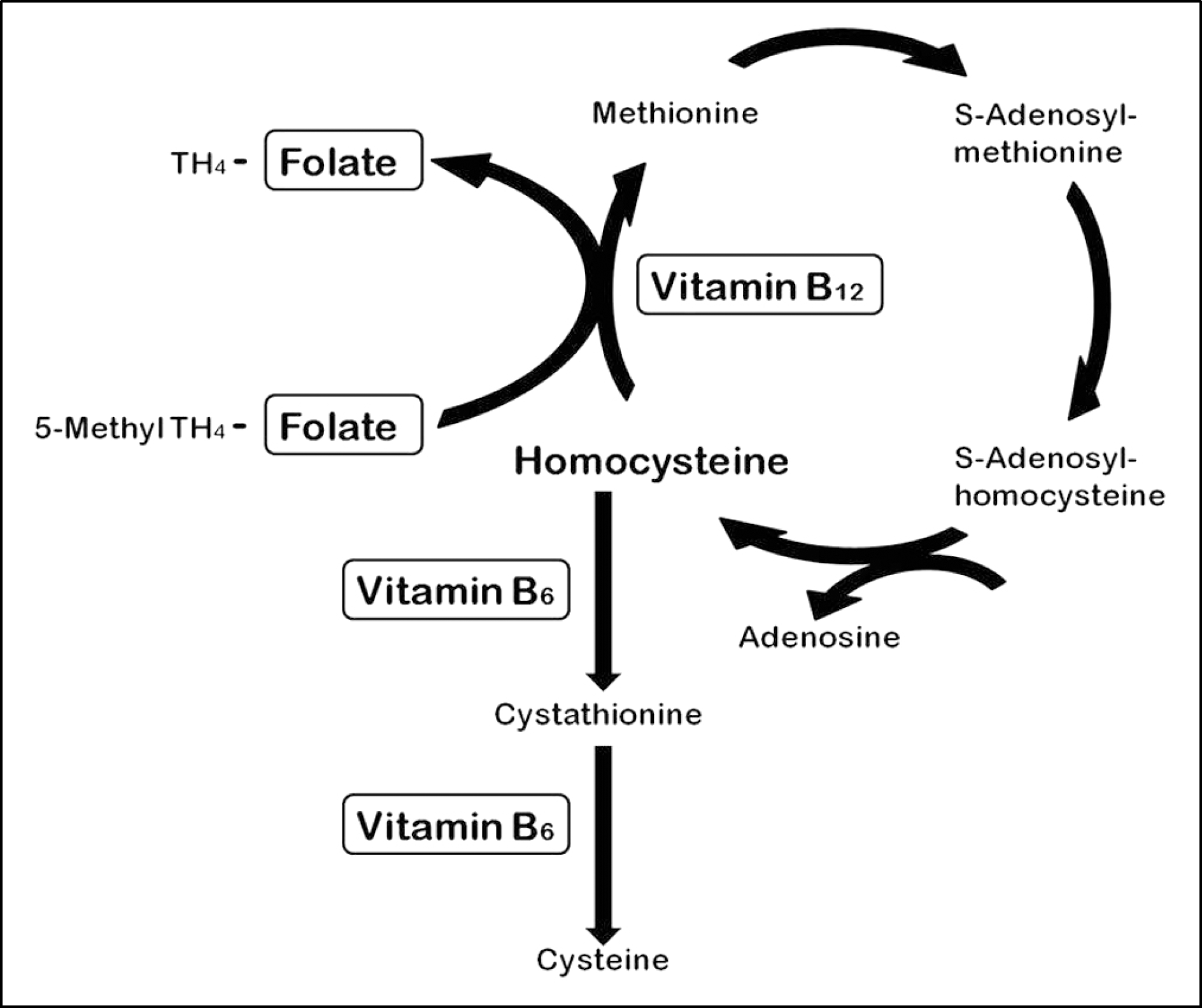Abstract
Purpose
To compare the levels of serum homocysteine, vitamin B12, vitamin B6 and folate in patients with normal-tension glaucoma, pseudoexfoliation glaucoma and high-tension glaucoma.
Methods
Thirty-two healthy subjects, 35 patients with normal-tension glaucoma, 22 patients with pseudoexfoliation glaucoma and 31 patients with high-tension glaucoma were included in the present study. Fasting venous samples were collected from all the participants. The levels of serum homocysteine, vitamin B12, vitamin B6 and folate were measured. One-way analysis of variance was used for the comparison of homocysteine, vitamin B12, vitamin B6 and folate levels among the 4 groups.
Results
The mean homocysteine levels in the pseudoexfoliation glaucoma and high-tension glaucoma group were 17.91 ± 5.11 and 17.60 ± 3.89 μ mol/l, respectively, which were significantly higher than that of the control group (p = 0.014, p = 0.013, respectively). The mean vitamin B6 levels in the pseudoexfoliation glaucoma and high-tension glaucoma group were 17.67 ± 14.32 and 17.00 ± 10.58 nmol/l, respectively, which were significantly lower than that of the control group (p = 0.026, p = 0.008, respectively).
Go to : 
References
1. Flammer J, Orgül S, Costa VP, et al. The impact of ocular blood flow in glaucoma. Prog Retin Eye Res. 2002; 21:359–93.

2. Hayreh SS. Blood flow in the optic nerve head and factors that may influence it. Prog Retin Eye Res. 2001; 20:595–624.

3. Ritch R. Exfoliation syndrome: beyond glaucoma. Arch Opthalmol. 2008; 126:859–61.
4. Carroll JF, Tyagi SC. Extracellular matrix remodeling in the heart of the homocysteinemic obese rabbit. Am J Hypertens. 2005; 18(5 Pt 1):692–8.

5. Mujumdar VS, Aru GM, Tyagi SC. Induction of oxidative stress by homocyst(e)ine impairs endothelial function. J Cell Biochem. 2001; 82:491–500.

6. Ramakrishnan S, Sulochana KN, Lakshmi S, et al. Biochemistry of homocysteine in health and diseases. Indian J Biochem Biophys. 2006; 43:275–83.
7. Finkelstein JD. The metabolism of homocysteine: pathways and regulation. Eur J Pediatr. 1998; 157:S40–4.

8. Biousse V, Newman NJ, Sternberg P Jr. Retinal vein occlusion and transient monocular visual loss associated with hyperhomocystinemia. Am J Ophthalmol. 1997; 124:257–60.

9. Cahill M, Karabatzaki M, Meleady R, et al. Raised plasma abdominal as a risk factor for retinal vascular occlusive disease. Br J Ophthalmol. 2000; 84:154–7.
10. Pianka P, Almog Y, Man O, et al. Hyperhomocystinemia in patients with nonarteritic anterior ischemic optic neuropathy, central retinal artery occlusion, and central retinal vein occlusion. Ophthalmology. 2000; 107:1588–92.

11. Loewenstein A, Goldstein M, Winder A, et al. Retinal vein abdominal associated with methylenetetrahydrofolate reductase mutation. Ophthalmology. 1999; 106:1817–20.
12. Brown BA, Marx JL, Ward TP, et al. Homocysteine: a risk factor for retinal venous occlusive disease. Ophthalmology. 2002; 109:287–90.
13. Kang SS, Zhou J, Wong PW, et al. Intermediate homocysteinemia: a thermolabile variant of methylenetetrahydrofolate reductase. Am J Hum Genet. 1988; 43:414–21.
14. Jacques PF, Bostom AG, Wilson PW, et al. Determinants of plasma total homocysteine concentration in the Framingham Offspring cohort. Am J Clin Nutr. 2001; 73:613–21.

15. Selhub J, Jacques PF, Wilson PW, et al. Vitamin status and intake as primary determinants of homocysteinemia in an elderly population. JAMA. 1993; 270:2693–8.

16. Ueland PM, Nygård O, Vollset SE, Refsum H. The Hordaland Homocysteine Studies. Lipids. 2001; 36(Suppl):S33–9.

17. Vine AK, Stader J, Branham K, et al. Biomarkers of cardiovascular disease as risk factors for age-related macular degeneration. Ophthalmology. 2005; 112:2076–80.

18. Roedl JB, Bleich S, Schlötzer-Schrehardt U, et al. Increased abdominal levels in tear fluid of patients with primary open-angle glaucoma. Ophthalmic Res. 2008; 40:249–56.
19. Bleich S, Jünemann A, von Ahsen N, et al. Homocysteine and risk of open-angle glaucoma. J Neural Transm. 2002; 109:1499–504.

20. Vessani RM, Ritch R, Liebmann JM, Jofe M. Plasma homocysteine is elevated in patients with exfoliation syndrome. Am J Ophthalmol. 2003; 136:41–6.

21. Fan BJ, Chen T, Grosskreutz C, et al. Lack of association of poly-morphisms in homocysteine metabolism genes with abdominal syndrome and glaucoma. Mol Vis. 2008; 14:2484–91.
22. Stamler JS, Osborne JA, Jaraki O, et al. Adverse vascular effects of homocysteine are modulated by endothelium-derived relaxing abdominal and related oxides of nitrogen. J Clin Invest. 1993; 91:308–18.
23. Tsai JC, Perrella MA, Yoshizumi M, et al. Promotion of vascular smooth muscle cell growth by homocysteine: a link to atherosclerosis. Proc Natl Acad Sci U S A. 1994; 91:6369–73.

24. Tang L, Mamotte CD, Van Bockxmeer FM, Taylor RR. The effect of homocysteine on DNA synthesis in cultured human vascular smooth muscle. Atherosclerosis. 1998; 136:169–73.

25. Rodgers GM, Conn MT. Homocysteine, an atherogenic stimulus, reduces protein C activation by arterial and venous endothelial cells. Blood. 1990; 75:895–901.

26. Rodgers GM, Kane WH. Activation of endogenous factor V by a homocysteine-induced vascular endothelial cell activator. J Clin Invest. 1986; 77:1909–16.

27. Clement CI, Goldberg I, Healey PR, Graham SL. Plasma homocysteine, MTHFR gene mutation, and open-angle glaucoma. J Glaucoma. 2009; 18:73–8.

28. Cumurcu T, Sahin S, Aydin E. Serum homocysteine, vitamin B12 and folic acid levels in different types of glaucoma. BMC Ophthalmol. 2006; 6:6.

29. Leibovitch I, Kurtz S, Shemesh G, et al. Hyperhomocystinemia in pseudoexfoliation glaucoma. J Glaucoma. 2003; 12:36–9.

30. Altintaş O, Maral H, Yüksel N, et al. Homocysteine and nitric abdominal levels in plasma of patients with pseudoexfoliation syndrome, pseudoexfoliation glaucoma, and primary open-angle glaucoma. Graefes Arch Clin Exp Ophthalmol. 2005; 243:677–83.
31. Fan BJ, Chen T, Grosskreutz C, et al. Lack of association of poly-morphisms in homocysteine metabolism genes with abdominal syndrome and glaucoma. Mol Vis. 2008; 14:2484–91.
32. Fingert JH, Kwon YH, Moore PA, et al. The C677T variant in the methylenetetrahydrofolate reductase gene is not associated with disease in cohorts of pseudoexfoliation glaucoma and primary open-angle glaucoma patients from Iowa. Ophthalmic Genet. 2006; 27:39–41.

33. Turaçli ME, Tekeli O, Ozdemir F, Akar N. Methylenetetrahydrofolate reductase 677 C-T and homocysteine levels in Turkish abdominals with pseudoexfoliation. Clin Experiment Ophthalmol. 2005; 33:505–8.
34. Bleich S, Roedl J, Von Ahsen N, et al. Elevated homocysteine levels in aqueous humor of patients with pseudoexfoliation glaucoma. Am J Ophthalmol. 2004; 138:162–4.

35. Roedl JB, Bleich S, Reulbach U, et al. Homocysteine in tear fluid of patients with pseudoexfoliation glaucoma. J Glaucoma. 2007; 16:234–9.

36. Puustjärvi T, Blomster H, Kontkanen M, et al. Plasma and aqueous humour levels of homocysteine in exfoliation syndrome. Graefes Arch Clin Exp Ophthalmol. 2004; 242:749–54.

37. Roedl JB, Bleich S, Reulbach U, et al. Homocysteine levels in aqueous humor and plasma of patients with primary open-angle glaucoma. J Neural Transm. 2007; 114:445–50.

38. Brunelli T, Prisco D, Fedi S, et al. High prevalence of mild hyperhomocysteinemia in patients with abdominal aortic aneurysm. J Vasc Surg. 2000; 32:531–6.

39. Roedl JB, Bleich S, Reulbach U, et al. Vitamin deficiency and hyperhomocysteinemia in pseudoexfoliation glaucoma. J Neural Transm. 2007; 114:571–5.

40. Brosnan JT, Brosnan ME. The sulfur-containing amino acids: an overview. J Nutr. 2006; 136(6 Suppl):1636S–40S.

41. Stipanuk MH, Ueki I. Dealing with methionine/homocysteine abdominal: cysteine metabolism to taurine and inorganic sulfur. J Inherit Metab Dis. 2011; 34:17–32.
Go to : 
 | Figure 1.Distribution of serum homocysteine (A), vitamin B12 (B), vitamin B6 (C) and folate (D) levels in control, normal-tension glaucoma (NTG), pseudoexfoliation glaucoma (PXG) and high-tension glaucoma groups. Black squares indicate the mean values; vertical bars indicate the 95% confidence intervals. |
Table 1.
Comparison of demographic and clinical characteristics among study groups
| Control (n = 32) | NTG (n = 35) | PXG (n = 22) | High-tension glaucoma (n = 31) | p-value | |
|---|---|---|---|---|---|
| Age | 60 ± 6 (50, 72) | 59 ± 7 (48, 70) | 62 ± 6(52, 74) | 60 ± 7(48, 73) | 0.216* |
| Sex (M/F) | 18/14 | 20/15 | 13/9 | 17/14 | 0.992† |
| Intraocular pressure (mm Hg) | 14.74 ± 2.24(13.94, 15.55) | 17.07 ± 1.57(16.53, 17.61) | 18.11 ± 2.00(17.22, 19.00) | 18.23 ±1.90(17.53, 18.92) | <0.001* |
| Spherical equivalent (diopter) | –0.62 ± 2.01(−1.35, 0.10) | –0.70 ± 1.95(−1.37, −0.03) | 0.35 ± 1.37(−0.25, 0.96) | –0.28 ± 1.73(−0.91, 0.37) | 0.210* |
| Central corneal thickness (μ m) | 552.75 ± 32.65(540.98, 564.52) | 546.84 ± 37.29(534.03, 559.65) | 520.89 ± 112.53(471.00, 570.78) | 549.77 ± 38.51(535.65, 563.90) | 0.155* |
| Cup-to-disc ratio | 0.33 ± 0.06(0.31, 0.35) | 0.67 ± 0.07(0.65, 0.70) | 0.71 ± 0.11(0.66, 0.76) | 0.70 ± 0.08(0.67, 0.73) | <0.001* |
Table 2.
Mean ± standard deviation (95% confidence interval) of serum homocysteine, vitamin B12, vitamin B6 and folate in study groups
| Control (n = 32) | NTG (n = 35) | PXG (n = 22) | High-tension glaucoma (n = 31) | p-value* | |
|---|---|---|---|---|---|
| Homocysteine (μ mol/l) | 14.15 ± 4.57(12.51, 15.80) | 15.17 ± 4.19(13.73, 16.60) | 17.91 ± 5.11(15.64, 20.17) | 17.60 ± 3.89(16.17, 19.02) | 0.003† |
| Vitamin B12 (pg/ml) | 479.03 ± 216.83(400.86, 557.21) | 490.28 ± 198.33(422.15, 558.41) | 491.56 ± 241.69(384.40, 598.71) | 495.48 ± 225.83(412.64, 578.31) | 0.992 |
| Vitamin B6 (nmol/l) | 32.42 ± 30.56(21.40, 43.44) | 24.05 ± 10.78(20.35, 27.76) | 17.67 ± 14.32(11.32, 24.02) | 17.00 ± 10.58(13.12, 20.88) | 0.006‡ |
| Folate (ng/ml) | 9.83 ± 5.36(7.90, 11.76) | 9.34 ± 2.10(8.62, 10.06) | 10.36 ± 2.99(9.04, 11.69) | 11.34 ± 2.93(10.27, 12.42) | 0.141 |
Table 3.
Correlation between intraocular pressure and serum homocysteine in study groups
| Correlation coefficient | p-value* | |
|---|---|---|
| Control | –0.197 | 0.280 |
| NTG | 0.132 | 0.449 |
| PXG | 0.099 | 0.663 |
| High-tension glaucoma | 0.086 | 0.646 |




 PDF
PDF ePub
ePub Citation
Citation Print
Print



 XML Download
XML Download